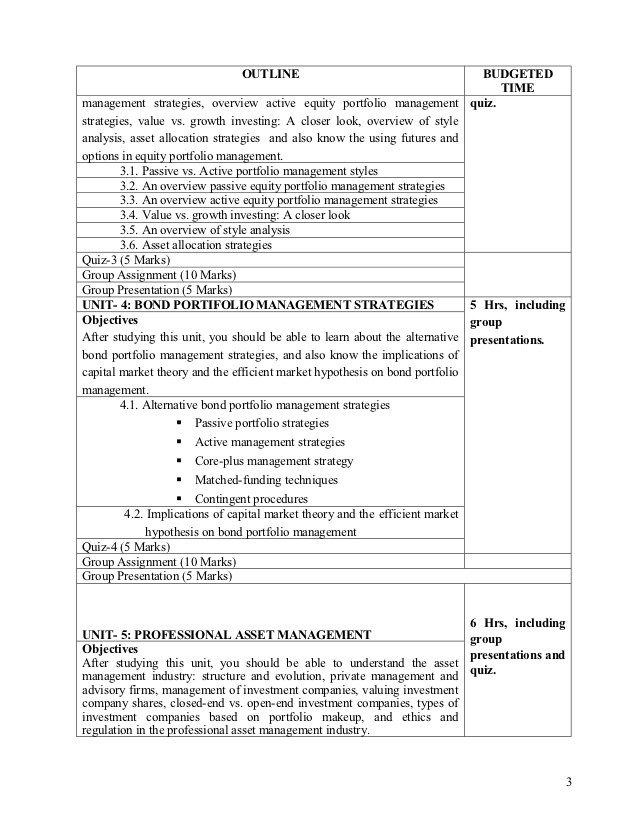Asset Allocation Strategies_5
Post on: 30 Март, 2015 No Comment

Establishing an appropriate asset mix is a dynamic process and it plays a key role in determining your portfolios overall risk and return. As such, your portfolios asset mix should reflect your goals at any point in time. There are a few different strategies of establishing asset allocations. and here we outline some of them and examine their basic management approaches.
Strategic Asset Allocation
Strategic asset allocation is a method that establishes and adheres to what is a base policy mix. This is a proportional combination of assets based on expected rates of return for each asset class. For example, if stocks have historically returned 10% per year and bonds have returned 5% per year, a mix of 50% stocks and 50% bonds would be expected to return 7.5% per year.
Constant-Weighting Asset Allocation
Strategic asset allocation generally implies a buy-and-hold strategy, even as the shift in the values of assets cause a drift from the initially established policy mix. For this reason, you may choose to adopt a constant-weighting approach to asset allocation. With this approach, you continually rebalance your portfolio. For example, if one asset were declining in value, you would purchase more of that asset, and if that asset value should increase, you would sell it.
There are no hard-and-fast rules for the timing of portfolio rebalancing under strategic or constant-weighting asset allocation. However, a common rule of thumb is that the portfolio should be rebalanced to its original mix when any given asset class moves more than 5% from its original value.
Tactical Asset Allocation
Over the long run, a strategic asset allocation strategy may seem relatively rigid. Therefore, you may find it necessary to occasionally engage in short-term, tactical deviations from the mix in order to capitalize on unusual or exceptional investment opportunities. This flexibility adds a component of market timing to the portfolio, allowing you to participate in economic conditions that are more favorable for one asset class than for others.
Tactical asset allocation can be described as a moderately active strategy, since the overall strategic asset mix is returned to when desired short-term profits are achieved. This strategy demands some discipline, as you must first be able to recognize when short-term opportunities have run their course, and then rebalance the portfolio to the long-term asset position.
Dynamic Asset Allocation
Another active asset allocation strategy is dynamic asset allocation, with which you constantly adjust the mix of assets as markets rise and fall and the economy strengthens and weakens. With this strategy you sell assets that are declining and purchase assets that are increasing, making dynamic asset allocation the polar opposite of a constant-weighting strategy. For example, if the stock market is showing weakness, you sell stocks in anticipation of further decreases, and if the market is strong, you purchase stocks in anticipation of continued market gains.
Insured Asset Allocation
With an insured asset allocation strategy, you establish a base portfolio value under which the portfolio should not be allowed to drop. As long as the portfolio achieves a return above its base, you exercise active management to try to increase the portfolio value as much as possible. If, however, the portfolio should ever drop to the base value, you invest in risk-free assets so that the base value becomes fixed. At such time, you would consult with your advisor on re-allocating assets, perhaps even changing your investment strategy entirely.

You can implement an insured asset allocation strategy with a formula approach or a portfolio insurance approach. The formula approach is a graduated strategy: as the portfolio value decreases, you purchase more and more risk-free assets so that when the portfolio reaches its base level, you are entirely invested in risk-free assets. With the portfolio insurance approach you would use put options and/or futures contracts to preserve the base capital. Both approaches are considered active management strategies, but when the base amount is reached, you are adopting a passive approach.
Insured asset allocation may be suitable for risk-averse investors who desire a certain level of active portfolio management but appreciate the security of establishing a guaranteed floor below which the portfolio is not allowed to decline. For example, an investor who wishes to establish a minimum standard of living during retirement might find an insured asset allocation strategy ideally suited to his or her management goals.
Integrated Asset Allocation
With integrated asset allocation you consider both your economic expectations and your risk in establishing an asset mix. While all of the above-mentioned strategies take into account expectations for future market returns, not all of the strategies account for investment risk tolerance. Integrated asset allocation, on the other hand, includes aspects of all strategies, accounting not only for expectations but also actual changes in capital markets and your risk tolerance. Integrated asset allocation is a broader asset allocation strategy, albeit allowing only either dynamic or constant-weighting allocation. Obviously, an investor would not wish to implement two strategies that are competing with one another.
Conclusion
Keep in mind, however, that this article gives only general guidelines on how investors may use asset allocation as a part of their core strategies. Be aware that allocation approaches that involve anticipating and reacting to market movements require a great deal of expertise and talent in using particular tools for timing these movements. Some would say that accurately timing the market is next to impossible, so make sure your strategy isnt too vulnerable to unforeseeable errors.
by Jason Van Berge














